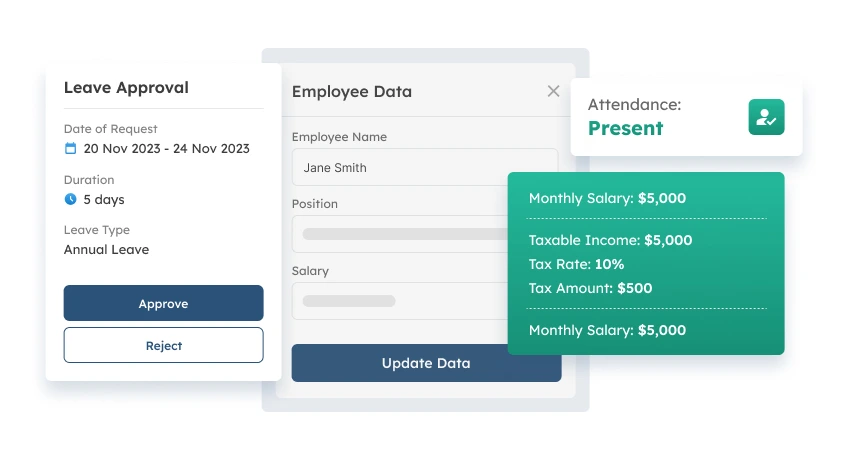An HRIS centralizes HR functions like payroll, employee records, and performance tracking, leading to benefits such as streamlined processes, improved compliance, and better data-driven decision-making. It can also increase talent productivity by automating routine tasks, reducing errors, and enhancing communication within the organization. Furthermore, employees benefit from self-service portals, which empower them to manage their personal information and access company-wide announcements, contributing to increased engagement and satisfaction.
By automating routine tasks and improving data accuracy, businesses may decrease administrative costs and focus on strategic growth. This article gives a complete overview of HRIS systems, including its definition, important features, and commercial advantages. Understanding these characteristics can assist firms in maximizing HR efficiency and improving employee experiences in an increasingly competitive market.
- Human Resources Information System (HRIS) is software that centralizes HR tasks like payroll, employee data, and performance tracking to improve efficiency and compliance.
- HR information systems (HRIS) play an important role in automating tasks, reducing errors, enhancing communication, and improving decision-making for HR operations.
- Choosing the right HRIS involves evaluating business needs, system integration, scalability, security, and user experience to streamline HR tasks and improve efficiency.
- ScaleOcean helps businesses streamline HR processes with customizable, cloud-based HRIS that supports scalability, improves compliance, and enhances workforce management.

What is the Human Resources Information System (HRIS)?
A Human Resources Information System (HRIS) is a software solution designed to streamline and manage HR processes, such as employee data, payroll, benefits administration, and performance management. By centralizing information, HRIS allows businesses to efficiently track and process employee-related tasks, improving decision-making and operational efficiency.
HRIS’s automation capabilities eliminate manual work while ensuring accurate and timely reporting. Companies may use HRIS to optimize HR operations, improve compliance, and create better employee experiences, making it an indispensable tool for modern HR management.
HRIS vs. HRMS vs. HCM: What’s the Difference?
Understanding the differences between three types of HR software is important for businesses looking to optimize their human resources operations. Each system offers unique features tailored to specific HR needs.
1. HRIS
A Human Resources Information System (HRIS) is designed to manage employee data and administrative tasks such as payroll, benefits, and attendance. One of the key benefits of HRIS is its ability to serve as a centralized database for HR departments to store and access critical personnel information, streamlining administrative operations and maintaining regulatory compliance.
2. HRMS
A Human Resource Management System (HRMS) enhances the capabilities of an HRIS by incorporating new activities such as talent management, recruitment, and performance evaluation. HRMS solutions automate HR tasks and provide strategic decision-making capabilities, resulting in a more comprehensive solution for better workforce management.
3. HCM
Human Capital Management (HCM) is a more holistic approach to managing an organization’s workforce. It combines HRIS and HRMS functionality while emphasizing employee development, strategic talent management, and workforce performance optimization. HCM solutions provide a comprehensive framework for integrating HR operations with corporate objectives and promoting a productive workplace.
What do HR Information Systems do?

HR information systems (HRIS) play an important role in streamlining human resource processes, improving efficiency, and reducing administrative workload. These systems help businesses manage employee data and HR functions effectively by implementing the following explanation.
1. Employee Data Management
HRIS centralizes employee information, such as personal details, job history, and payroll records. This allows HR departments to access and manage employee data efficiently, ensuring accuracy and compliance with legal requirements.
2. Payroll and Compensation Management
HRIS automates payroll processes, ensuring timely and accurate salary payments. It helps track employee earnings, bonuses, tax calculations, and benefits, reducing errors and ensuring compliance with tax laws and company policies.
3. Recruitment and Onboarding
HRIS facilitates the recruitment process by managing job postings, applicant tracking, and candidate evaluations. It also simplifies onboarding by automating document gathering, training schedules, and system integration, making the process easier for new staff.
4. Performance Management
HRIS offers tools for monitoring employee performance, such as goal setting, evaluations, and feedback. This assists organizations in identifying top performers, managing employee growth, and aligning individual goals with corporate objectives, thereby increasing productivity.
5. Compliance and Reporting
HRIS ensures that companies stay compliant with labor laws by tracking critical dates, managing compliance documents, and generating reports such as payslip template. The system helps HR teams stay up-to-date with legal requirements and maintain proper records for audits.
HRIS Features, Functions, and Users
HRIS (Human Resources Information System) provides essential features and functions to streamline HR operations, improve efficiency, and ensure compliance. Below, we’ll explore the key features and functions of HRIS that help businesses optimize their HR processes.
1. Employee Data Management
HRIS centralizes employee information such as personal details, employment history, and benefits. This feature helps HR teams manage data efficiently, providing quick access and reducing errors, while ensuring legal compliance.
2. Payroll and Compensation
HRIS automates payroll calculations, tax deductions, and benefit distributions, ensuring accurate and timely payments. It also generates reports, tracks overtime, and simplifies compensation management, reducing administrative workload and errors.
3. Recruitment and Onboarding
HRIS simplifies recruitment by managing job postings, applications, and candidate screenings. It also automates onboarding tasks, such as document collection and training schedules, ensuring a smooth transition for new hires and improving their experience.
4. Performance Management
HRIS offers tools to monitor employee performance, set goals, and conduct evaluations. It enables HR teams to track achievements, identify areas for development, and align employee goals with company objectives, promoting productivity and growth.
5. HRIS Users
HRIS is used by HR departments, managers, and employees. HR staff utilize it for administrative tasks, while managers access performance and payroll data. Employees can view personal records, pay slips, and request time off, improving communication and efficiency across the organization.
Benefits of a Cloud HRIS System
A cloud HRIS system offers a range of benefits that help streamline HR tasks, improve efficiency, and ensure compliance. By automating administrative processes, businesses can enhance their HR functions and focus on strategic goals.
1. Faster and More Accurate HR Administration
Cloud HRIS automates administrative tasks, reducing the chances of errors and delays. This ensures HR teams can manage processes like payroll and employee benefits more quickly and accurately, avoiding costly mistakes.
2. Enhanced Employee Experience
Employees can access personal information, track benefits, and request time off directly through the cloud HRIS. This self-service capability improves their overall experience by saving time and reducing dependency on HR staff.
3. Improved Efficiency
By eliminating paper-based forms and automating workflows, a cloud HRIS system increases efficiency across the board. Employees can handle tasks like schedule management and leave requests in real time, making HR operations smoother and faster.
4. Supports Compliance Efforts
Cloud HRIS systems help companies stay compliant with labor laws and regulations, particularly in remote work environments. These systems ensure HR activities adhere to the latest legal standards, reducing risks of non-compliance.
5. Advanced Security Features
With sensitive employee data stored securely in the cloud, modern HRIS systems come with robust security protocols. This minimizes cybersecurity risks and ensures that confidential employee records are well-protected from unauthorized access.
How Cloud HRIS Integration Supports Core HR Processes
Cloud HRIS integration streamlines core HR processes by centralizing employee data, automating administrative tasks, and enhancing real-time access to critical information. It simplifies payroll, attendance tracking, and compliance management while ensuring seamless connectivity with other business systems.
HR teams use automated workflows to reduce manual effort, minimize errors, and improve decision-making based on data. Cloud-based access increases flexibility by allowing HR professionals to manage operations remotely. A cloud HRIS improves employee experience, boosts efficiency, and enables scalable workforce management for growing businesses by integrating with existing tools.
Who Benefits from an HRIS?
An HRIS benefits HR professionals, business leaders, and employees by streamlining workforce management and improving efficiency. HR teams use it to automate payroll, track attendance, and ensure compliance, reducing manual tasks and errors. Business leaders gain real-time insights into workforce data, enabling better decision-making and strategic planning.
Employees benefit from self-service portals for leave requests, payslip access, and performance tracking, enhancing their experience. Whether for small businesses or large enterprises, an HRIS supports scalable HR processes, ensuring seamless operations and improved productivity across the organization.
What Business Problems Does an HRIS Solve?

A Human Resource Information System (HRIS) automates HR operations, boosts efficiency, and ensures compliance. Employee data management, payroll automation, and performance tracking are essential features for modern businesses. Let’s look at its key features and users.
1. Eliminating Manual HR Processes
Manual HR tasks, such as payroll processing, attendance tracking, and employee data management, are time-consuming and prone to errors. An HRIS automates these functions, reducing paperwork and administrative workload. By integrating data across HR operations, businesses improve accuracy, ensure efficiency, and free up HR teams for more strategic initiatives.
2. Enhancing Compliance and Reducing Risks
Keeping track of labor laws, tax regulations, and employee records can be complicated. An HRIS ensures compliance by automatically updating policies, creating reports, and keeping accurate documentation. It lowers the likelihood of legal penalties and audits by ensuring that businesses comply with industry standards, government regulations, and internal policies.
3. Improving Workforce Data Management
It can be difficult to track employee information, conduct performance reviews, and perform workforce analytics without a centralized system. An HRIS compiles all HR data into a secure, cloud-based platform, providing easy access to real-time insights. This enables HR professionals and business leaders to make informed decisions based on reliable workforce data.
4. Optimizing Employee Experience and Engagement
Employee satisfaction is crucial for productivity and retention. An HRIS provides self-service portals where employees can access payslips, update personal details, request leave, and track performance. This transparency fosters engagement, reduces dependency on HR staff for basic inquiries, and enhances overall job satisfaction, leading to a more motivated workforce.
What Considerations Must Be Undertaken Before Deploying an HRIS?
By considering the essential factors, businesses can ensure that the chosen HRIS aligns with their unique needs and goals. In the following sections, we’ll explore some important considerations to keep in mind before deploying an HRIS.
1. Assessing Business Needs and Objectives
Before deploying an HRIS, companies must identify their HR challenges and objectives. Understanding specific requirements, such as payroll automation, compliance tracking, or employee self-service, ensures that the chosen system aligns with business goals, enhances efficiency, and supports workforce management effectively.
2. Ensuring System Compatibility and Integration
An HRIS should work smoothly with other business applications like payroll software Singapore, accounting systems, and workforce management tools. System compatibility testing ensures that data flows smoothly, prevents operational disruptions, and increases efficiency by reducing the need for manual data entry across multiple platforms.
3. Prioritizing Data Security and Compliance
HRIS platforms handle sensitive employee information, making data security a top priority. Businesses must ensure that the system complies with industry regulations, offers encryption protocols, and includes access controls to protect confidential HR data from breaches, unauthorized access, or compliance violations.
4. Budgeting for Implementation and Maintenance
The expense of implementing an HRIS goes beyond the initial setup fee. Businesses must account for continuous maintenance, software updates, and prospective scaling costs. Evaluating overall ownership costs assures the system’s economic viability while also offering long-term efficiency and value to HR functions.
Also read: What is ERP Security and its Importance
Tips for Selecting the Right HRIS
Choosing the right HRIS involves evaluating functionality, integration, scalability, security, and user experience to ensure it meets business needs, boosts efficiency, and supports growth. Focusing on these factors will guide your decision. Below, we break down each consideration to help with your selection process.
1. Identify Business Needs and HR Goals
Understanding specific HR challenges and objectives helps businesses choose an HRIS that aligns with their needs. Whether it’s payroll automation, compliance tracking, or employee self-service, defining priorities ensures the chosen system enhances efficiency and supports strategic HR functions effectively.
2. Evaluate System Integration Capabilities
A smooth HRIS should be compatible with existing business systems such as payroll, accounting, and labor management solutions. Compatibility reduces manual data entry, optimizes operations, and boosts overall productivity by providing a cohesive digital ecosystem within the firm.
3. Prioritize Scalability for Future Growth
Businesses’ human resource requirements evolve as they grow. Choosing an HRIS that scales with workforce expansion and operational complexity ensures long-term value. A flexible system with customizable features helps organizations adapt to changing HR requirements without costly system upgrades or replacements.
4. Assess Security and Compliance Features
An HRIS handles sensitive employee data, making security a top priority. Businesses should select a platform with strong encryption, access controls, and compliance features to protect confidential information and meet regulatory requirements, reducing the risk of data breaches or legal penalties.
5. Consider User Experience and Support
A user-friendly HRIS increases adoption rates and efficiency. Businesses should seek for simple interfaces, mobile accessibility, and dependable customer service. Training materials and specialized support teams ensure a seamless installation and assist staff in realizing the system’s potential for improved HR management.
8 Best HRIS System Recommendations in Singapore
Now that we have covered the key factors to consider when selecting the right HRIS, let’s dive into some options. In the next section, we have put together a list of the 8 best HRIS systems in Singapore that can help streamline your HR processes and meet your business needs.
1. ScaleOcean

ScaleOcean HRIS is a cloud-based Human Resource Information System that streamlines and automates key HR functions, including payroll, attendance tracking, employee records, and performance management. It also ensures compliance with Singapore’s labor and tax regulations. Moreover, its unlimited user model makes it a cost-effective choice for companies planning to scale, eliminating per-user fees that many other platforms charge. If you’d like to see it in action, try a free demo with no commitment required.
With built-in customization, businesses can tailor workflows to match their specific needs, improving HR efficiency and employee experience. Additionally, seamless integration with finance, ERP, and other business systems ensures a smooth flow of data, reducing administrative workload and enhancing decision-making. ScaleOcean HRIS, whether for SMEs or large organizations, helps streamline HR procedures, minimize errors, and deliver greater worker insights, all of which support business growth and sustainability.
Key Features of ScaleOcean HRIS:
- Payroll Automation: Ensures accurate salary calculations, tax deductions, and compliance, reducing manual effort.
- Attendance & Leave Management: Tracks work hours, overtime, and leave requests seamlessly in one system.
- Employee Database & Records: Keeps employee data centralized and accessible for easy management.
- Performance & Talent Management: Helps monitor employee growth, set KPIs, and support career development.
- Customizable Workflow & Integration: Adapts to company-specific HR processes and integrates smoothly with other systems.
2. Talenox
Talenox is a cloud-based Human Resource Information System (HRIS) designed to simplify payroll, leave management, and employee data administration. It is particularly well-suited for businesses in Singapore due to its compliance with local employment laws and automated tax calculations. With an intuitive interface and seamless integration with accounting and workforce management tools, Talenox helps businesses automate routine HR tasks, reduce manual errors, and enhance efficiency.
3. QuickHR
QuickHR is a cloud-based Human Resource Information System (HRIS) developed in Singapore, designed to streamline and automate essential HR functions. It offers comprehensive solutions for payroll processing, attendance tracking, employee records management, and performance appraisals, ensuring compliance with Singapore’s labor and tax regulations. Hosted on secure Amazon Web Services (AWS) servers, QuickHR provides reliable and scalable HR management for businesses of all sizes.
4. Zoho People
Zoho People is a cloud-based HRIS designed to automate and streamline various HR processes. It offers a comprehensive suite of tools, including employee database management, attendance and leave tracking, performance appraisals, and learning management. This platform enables organizations to manage their human resources efficiently, ensuring seamless operations and improved employee engagement.
5. PeopleHub
PeopleHub is a cloud-based Human Resource Information System (HRIS) developed by Zalaris, designed to streamline and automate essential HR functions. It offers comprehensive solutions for managing employee data, tracking attendance, processing payroll, and facilitating performance appraisals. Hosted on secure servers, PeopleHub ensures data protection while providing globally accessible HR management tools suitable for companies of all sizes.
6. JustLogin
JustLogin is a cloud-based HRIS built to simplify and automate key HR tasks for businesses in Singapore. It provides a full suite of solutions, including payroll management, leave tracking, attendance monitoring, and employee self-service. Designed with compliance in mind, it ensures adherence to local labor and tax regulations. With secure cloud hosting, JustLogin delivers a scalable and dependable HR management system suitable for businesses of all sizes, helping them enhance efficiency and streamline workforce operations effortlessly.
7. Frontier e-HR
Frontier e-HR is a cloud-based Human Resource Information System (HRIS) designed to streamline and automate essential HR functions. It offers a suite of solutions, including personnel management, payroll processing, leave and claims management, and employee engagement tools. The platform ensures compliance with local labor and tax regulations, providing a reliable and scalable HR management system suitable for businesses of all sizes.
8. ZingHR
ZingHR is a cloud-based Human Resource Information System (HRIS) designed to automate and streamline various HR processes. It provides a variety of services, including personnel data management, payroll processing, attendance monitoring, performance management, and recruitment. The platform guarantees that local labor and tax requirements are followed, while also delivering a dependable and scalable HR management solution ideal for organizations of all sizes.
Conclusion
Implementing a Human Resource Information System (HRIS) can enhance efficiency by streamlining HR tasks like payroll, attendance, and performance tracking. With the rise of automation and cloud solutions, ScaleOcean HRIS optimizes workforce management and ensures compliance. Platforms like ScaleOcean support businesses of all sizes, making it essential to choose one that meets your specific needs and scalability.
For businesses seeking a solution, ScaleOcean offers a customizable, integrated solution that aligns with your HR goals. Its unlimited user model allows for seamless scaling without per-user fees, while its cloud-based system provides flexibility and security for remote management. Explore ScaleOcean’s free demo to see how it can streamline HR processes and support business growth.







 PTE LTD..png)
.png)

.png)








.png)
.png)
















